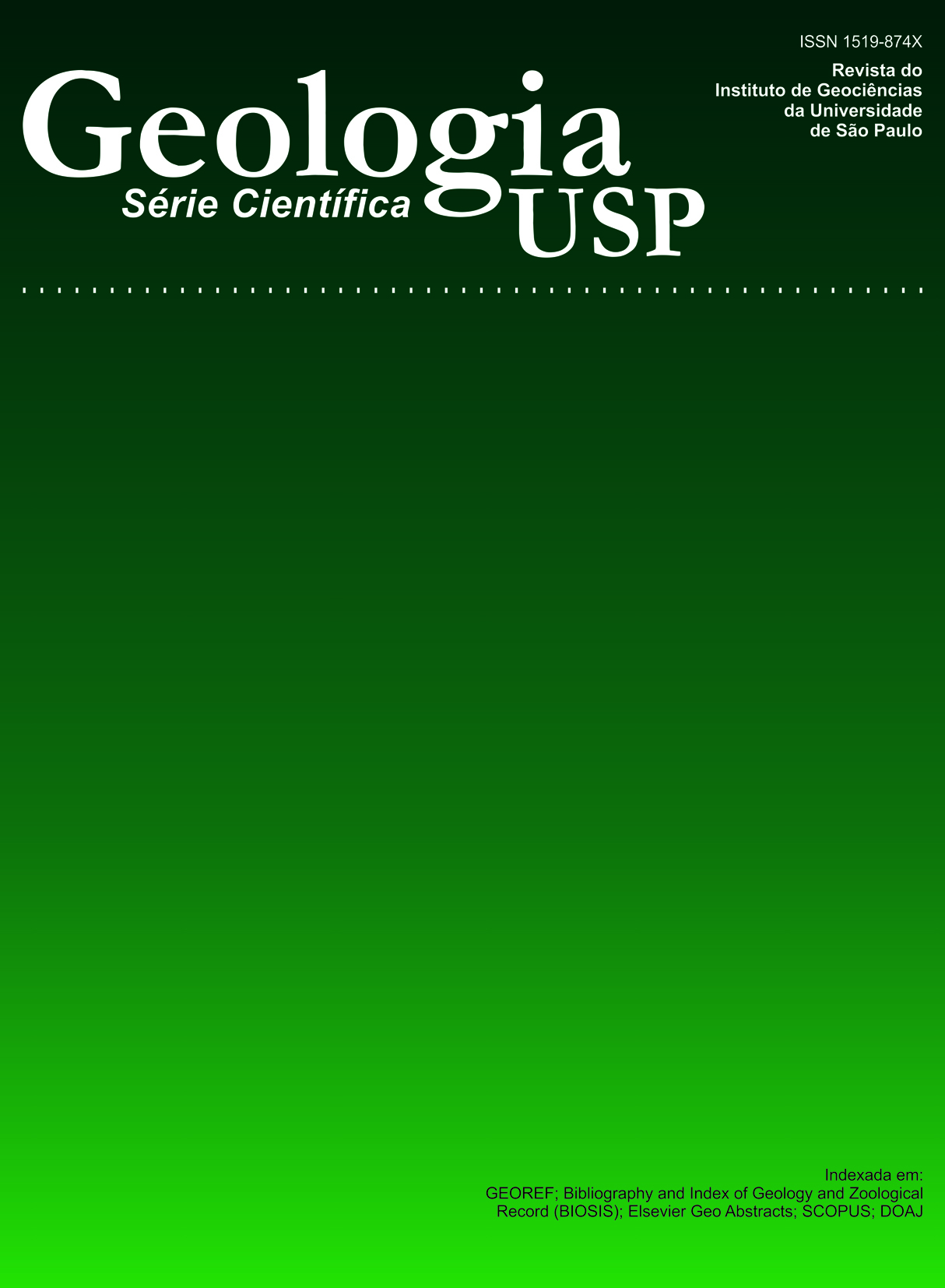Migração de orógenos e superposição de orogêneses: um esboço da colagem brasiliana no Sul do Cráton do São Francisco, SE - Brasil
DOI:
https://doi.org/10.5327/S1519-874x2004000100002Palavras-chave:
geocronologia, petrologia metamórfica, migração de orógenosResumo
O Orógeno Tocantins Meridional representa a pilha colisional de nappes entre três ambientes tectônicos principais (de WSW para ENE): domínio de arco magmático desenvolvido na margem continental ativa da Placa Paranapanema (Nappe Socorro-Guaxupé), domínio continental subductado (Terreno Andrelândia) e domínios com afinidades de margem passiva e/ou relacionados à Placa Sanfranciscana (Sistema de Nappes Carrancas e Nappe Lima Duarte). O magmatismo relacionado ao período de subducção remonta a 670 Ma, com auge metamórfico (geoterma relaxada na margem ativa e perturbada no terreno subductado) há 625 Ma. A atividade de arco na margem ativa foi contemporânea à sedimentação tipo-flysch no Terreno Andrelândia. Os processos metamórficos e deformacionais da etapa orogênica controlada por colisão frontal migraram para ENE de ca. 620 a 580 Ma. A duração dos processos foi"instantânea" na nappe interna ocidental (ca. 7 Ma, com plutonismo pós-orogênico há 612 Ma) e perdurou por ca. de 20 Ma na nappe oriental de alta pressão. O terreno subductado registrou rápida velocidade de exumação (ca. 2,2 mm/ano). Atividades magmáticas superimpostas, controladas por regimes extensionais (Cinturão Itu) acompanharam a exumação do orógeno e precederam a instalação de bacias sucessoras continental-marinhas há 570 Ma. O Orógeno Araçuaí, relacionado à convergência entre a margem passiva oriental Sanfranciscana e o Terreno Juiz de Fora (microplaca em ambiente de margem ativa) registrou o auge metamórfico colisional no domínio interno há 563 Ma. A migração das nappes Araçuaí contra o domínio cratônico, com o pico térmico metamórfico há 530 Ma, reflete a superposição de eventos colisionais múltiplos no Sistema Orogênico Mantiqueira. O embasamento da borda cratônica foi regenerado no Cambriano e engajado ductilmente no orógeno. Cavalga o domínio de foreland, no Quadrilátero Ferrífero, caracterizado por sistema thin-skinned de cavalgamento segmentado por domos do embasamento e calhas sinformais das supra-crustais. A colisão oblíqua entre o Sistema Orogênico Mantiqueira e o protocontinente consolidado pelo Orógeno Tocantins Meridional foi responsável pelo metamorfismo facies xisto-verde baixo das bacias sucessoras e migrou para norte, de 555 a 500 Ma. A colagem orogênica brasiliana, no sul do Cráton do São Francisco, representou a interação entre etapas orogênicas curtas em um longo processo de convergência, consumo de placas e migração de orógenos até o limite Cambro-Ordoviciano. O último evento metamórfico pré-colagem no embasamento cratônico ocorreu entre 2,03 - 2,06 Ga provavelmente sob regime extensional.Downloads
Os dados de download ainda não estão disponíveis.
Downloads
Publicado
2004-04-01
Edição
Seção
Artigos
Licença
Autores que publicam nesta revista concordam com os seguintes termos:
- Autores mantém os direitos autorais e concedem à revista Geologia USP. Série Científica, o direito de primeira publicação, com o trabalho sob a licença Creative Commons BY-NC-SA (resumo da Licença: https://creativecommons.org/licenses/by-nc-sa/4.0 | texto completo da licença: https://creativecommons.org/licenses/by-nc-sa/4.0/legalcode) que permite o compartilhamento do trabalho de forma não comercial e conferindo os devidos créditos autorais da primeira publicação nesta revista.
- Autores têm autorização para assumir contratos adicionais separadamente, para distribuição não-exclusiva da versão do trabalho publicada nesta revista (publicar em repositório institucional ou como capítulo de livro), conferindo os devidos créditos autorais da primeira publicação nesta revista.
- Autores têm permissão e são estimulados a publicar e distribuir seu trabalho online (em repositórios institucionais ou na sua página pessoal) a qualquer ponto antes ou durante o processo editorial, uma vez que isso pode gerar alterações produtivas, bem como aumentar o impacto e a citação do trabalho publicado (Veja O efeito do Acesso Aberto e downloads no impacto das citações).
Como Citar
Campos Neto, M. da C., Basei, M. A. S., Vlach, S. R. F., Caby, R., Szabó, G. A. J., & Vasconcelos, P. (2004). Migração de orógenos e superposição de orogêneses: um esboço da colagem brasiliana no Sul do Cráton do São Francisco, SE - Brasil . Geologia USP. Série Científica, 4(1), 13-40. https://doi.org/10.5327/S1519-874x2004000100002















